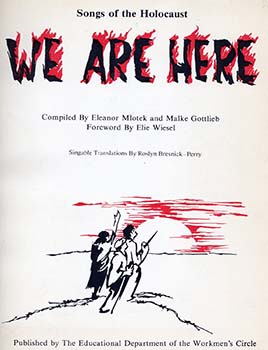Song written in the Vilno ghetto by Kasriel Broydo (1907 – 1945), author and director of theater revues and concerts in the ghetto. He was arrested by the Gestapo and deported to a Latvian concentration camp. In January, 1945 he was transferred to Germany and was forcibly drowned in the Baltic Sea near Konigsburg together with hundreds of other Jews. Composer unknown.

The same streets and the trolleys running
Numbers eleven and four.
The same newsboys — they’re rushing, shouting
To sell their papers – news galore.
The same blue sky – but not the same now
Are people under it,
The sun is shining I don’t know how,
No thought can make this riddle fit.
Oh, should it be this way?
Oh, must it be this way?
For a few there is life and joy
And for the others a world destroyed,
Who was the one to say
This world should be this way?
My heart seeks, it wants to know
Why must it be so;
Why must it be?
For them the boulevards and plazas,
For me a pauper’s place.
Forever fooled, my life haphazard?
For me the lonely depths to face;
Why should there be a sign declaring:
No further may you go?
Oh, why for them my house to live in.
For me no bed, no warmth to know?
Oh, should it be this way . . .
Di zelbe gasn un tramvayen
Numern elf un fir.
Di zelbe yinglekh loyfn, shrayen:
“A tsaytung koyft zhe, koyft bay mir.”
Der zelber himl, nor nit enlekh —
Der mentsh vos unter im,
Es shaynt di zun alts nit farshtendlekh,
Ikh her, es fregt in mir a shtim:
Tsi darf es azoy zayn?
Tsi muz es azoy zayn?
Az far eynem iz glik bashert —
Un far dem tsveytn iz alts farvert.
Ver hot es ayngeshtelt,
Azoy zol zayn di veit?
Es fregt, un vekt dos harts mayns:
Tsi darf azoy zayn?
— Darf azoy zayn?
Far zey di skvern un bulvarn,
Far mir aza kvartal.
Far vos zol yener mikh alts narn?
Far vos far mir a trern-kval?
Far vos der oyfshrift afn bretl:
“Farvert iz vayter geyn”?
Far vos far zey mayn heym, mayn betl —
Un mayn geleger hart vi shteyn?
Tsi darf es azoy zayn?
די זעלבע גאַסן און טראַמװײַען
נומערן עלף און פֿיר
די זעלבע ייִנגלעך לױפֿן, שרײַען:
„אַ צײַטונג קױפֿט זשע. קױפֿט בײַ מיר“.
דער זעלבער הימל, נאָר ניט ענלעך —
דער מענטש װאָס אונטער אים,
עס שײַנט די זון אַלץ ניט פֿאַרשטענדלעך,
איך הער עס פֿרעגט אין מיר אַ שטים:
צי דאַרף עס אַזױ זײַן?
צי מוז עס אַזױ זין?
אַז פֿאָר אײנעם איז גליק באַשערט —
און פֿאַר דעם צװײטן איז אַלץ פֿאַרװערט,
װער האָט עס אײַנגעשטעלט,
אַזױ זאָל זײן די װעלט?
עס פֿרעגט און װעקט דאָס האַרץ מײַנס:
צי דאַרף אַזױ זײַן?
— דאַרף אַזױ זײַן?
פֿאַר זײ די סקװערן און בולװאַרן,
פֿאַר מיר אַזאַ קװאַרטאַל.
פֿאַר װאָס זאָל יענער מיך אַלץ נאַרן?
פֿאַר װאָס פֿאַר מיר אַ טרערן־קװאַל?
פֿאַר װאָס דער אױפֿשריפֿט אױפֿן ברעטל:
„פֿאַרװערט איז װײַטער גײן“?
פֿאַר װאָס פֿאַר זײ מײַן הײם, מײַן בעטל —
און מײַן געלעגער האַרט װי שטײן?
צי דאַרף עס אַזױ זײַן?
Song Title: Tsi Darf Es Azoy Zayn

Compiled by sisters Malke Gottleib and Chana Mlotek, this collection of 40 songs, issued on the occasion of the 40th anniversary of the Warsaw Ghetto Uprising, reflects the suffering, despair, longing, as well as the strength, hope and courage that led the last remnant of enfeebled Jews to take up arms against the mammoth Nazi war-machine. Save for five songs, this compilation comprises songs that were actually written or sung in the ghettos and concentration camps. Four exceptions written after the war: “Babi Yar,” “Moyshelekh un Shloymelekh,” “Kadish,” and “Mayn mame hot gevolt zayn oyf mayn khasene” are often presented at commemorative gatherings and were therefore included. The fifth song “Am Yisroel Khay” was written in a D.P. camp and is an affirmation of the will of the survivors to build new lives for themselves, holding high their belief in the endurance of the Jewish people. To enable readers and singers not conversant with the Yiddish alphabet to utilize this collection, We Are Here! Songs of the Holocaust provides parallel transliterations and singable English translations by Roslyn Bresnick Perry.